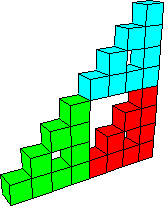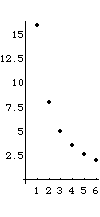| Recognizing the bracketed sum in An as a finite geometric series, we see |
An = 6*3n*(1/4)n-1 -
4*(1/4)n-1*(1 + 3 + 32 + ... + 3n-1) |
= 6*3n*(1/4)n-1 - 4*(1/4)n-1*((1 - 3n)/(1 - 3)) |
= 12*(3/4)n-1 + 2*(1/4)n-1 - 6*(3/4)n-1 |
= 6*(3/4)n-1 + 2*(1/4)n-1 |
| So An -> 0 as n -> infinity. |
| Consequently, the limiting shape has zero area. |
| This is no surprise: the limiting shape is a
right isosceles gasket, having dimension Log(3)/Log(2) < 2. |
| Area is a 2-dimensional measure, so the area of a Log(3)/Log(2)-dimensional object
is 0. |






